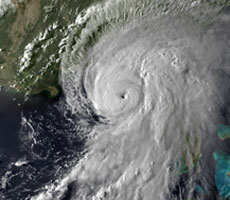After meandering around the Gulf of Mexico as a tropical depression, Hurricane Hermine gathered steam and headed straight for the Big Bend coast on September 2. The first hurricane to hit Florida in 11 years, Hermine did most of its damage with a 7-9 foot tidal surge and waves driven by 70-80 knot winds. Cedar Key and several other coastal towns bore the brunt of the storm. Damage to hard clam and oyster crops has been described as catastrophic. In anticipation of the hurricane, several growers in Cedar Key participating in the project were able to retrieve their oyster gear and hold juvenile oysters in either nursery systems or protected waters. One grower left his bottom cages on his lease and all were lost. In the Panhandle, little damage was reported by growers in Oyster Bay (Wakulla County) using the adjustable longline system or by growers in Alligator Harbor (Franklin County) using the floating bag system. A little over a month later, Hurricane Matthew, a very powerful category 5 storm, took aim at Florida, but its path kept it off the west coast. However, several growers moved their oyster bags in anticipation of potential impacts. One grower kept his oysters on his boat for over a day and noted that about half of the diploids died as a result.
 Culturing shellfish can be a high risk enterprise; hurricanes and storms can be particularly devastating to oysters which are grown off-bottom. The Noninsured Crop Disaster Assistance Program (NAP), administered by the USDA Farm Service Agency (FSA), provides financial assistance to growers of non-insurable crops to protect against natural disasters that result in crop losses. Oyster culture is now covered by NAP in several Florida counties. Although the deadline to sign-up for 2017 crop year has passed, growers should contact their local FSA office to learn more about this program.
Culturing shellfish can be a high risk enterprise; hurricanes and storms can be particularly devastating to oysters which are grown off-bottom. The Noninsured Crop Disaster Assistance Program (NAP), administered by the USDA Farm Service Agency (FSA), provides financial assistance to growers of non-insurable crops to protect against natural disasters that result in crop losses. Oyster culture is now covered by NAP in several Florida counties. Although the deadline to sign-up for 2017 crop year has passed, growers should contact their local FSA office to learn more about this program.
Update on UF Oyster Culture Study
On August 30, the eight oyster bags at the UF lease were retrieved and juvenile oysters placed in the UF shore-based nursery system, which pumps saltwater from conditionally approved waters. At which time, a count of live and dead oysters per bag was done and very low mortality was noted for each ploidy type(<2%). After the hurricane, the lease was inspected and longlines were intact. On September 14, the oysters were replanted at the UF lease using eight 9 mm mesh bags per ploidy type with triploids stocked at 7 liters per bag and diploids at 4.8 liters per bag. Oysters were maintained in these bags through October 6, at which time the bags were again retrieved in anticipation of potential impacts from Hurricane Matthew. Oysters were measured and shell metrics were similar for both ploidy types (3N, 47 mm [1.9”]; 2N, 45 mm SH [1.8”]). However, the triploids were 50% heavier than the diploids with average total weights of 17.0 grams for triploids and 11.4 grams for diploids. It was decided to hold the oysters in the nursery while preparation for stocking the growout study was completed.

